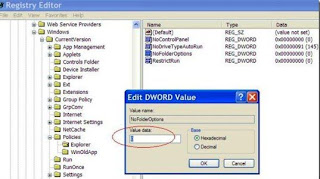Trouble:
Are you among those who are not able to access or see your folder options under File
Menu>>Tools in Windows Explorer on your Windows XP ? This problem of hidden or
disabled folder options occur normally due to malicious virus (w32.rontokbro@mm)
activity.
The virus creates an entry in registry to disable “Folder Options” in Windows explorer.
Let us see how we can fix it.
Fix:
In most of the cases, even if the virus is been already removed by your anti-virus
program, it doesn’t restore the registry back to the original state. Also anti-virus usually
does not delete the registry entry created by the virus.
For restoring the registry settings,follow the steps given below
Enable your folder options in explorer.
1. Go to Start > RUN
2. Type regedit and press enter.
3. Go to HKEY_CURRENT_USER > Software > Microsoft > Windows >
CurrentVersion > Policies > Explorer

4.On the right side of the screen, you can see some registry entry names, out of them,
right-click on NoFolderOptions and click Modify option.
5.A new small screen pops up, on this screen, sen the value data field as 0 (zero).Press
OK.
That’s it but it requires reboot. Trouble Fixed.

